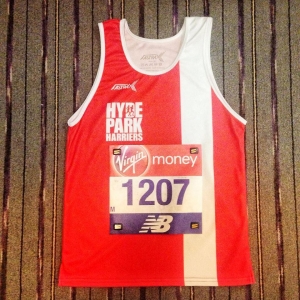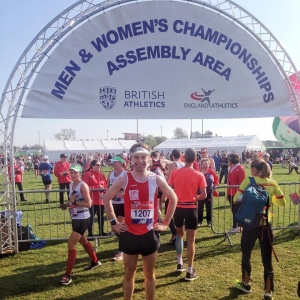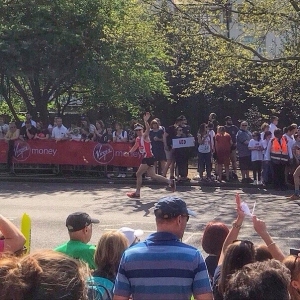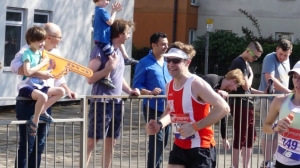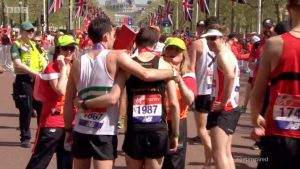How to join our Tuesday club runs - Read More
London Marathon 2018: the race report
It’s the biggest marathon in the UK. Some might say the biggest marathon in the world. The London Marathon went off with a bang last week, and my legs have just about recovered, so it’s time to look back and see what happened in my race.
Expectations
I’d approached the final run in to race week with strong designs on a 2:43 or lower marathon. The closer I got to race day, and when other spring marathon results meant I still held the club record, the more I looked at sub 2:40 as the target.
Then the heatwave started during race week, and looked set to stay for race day – meaning temperatures of around 18 – 20 celsius. These aren’t tropical temperatures, but enough to make running more difficult, and all of the advice in the run-up to race day was to adjust your target down – ‘Slow down to cool down’.
When you’re looking to absolutely push your limits to go under 2:40, to improve on a 2:44 PB, accepting that is hard. People want different things out of the marathon, but I had trained to go for that time. As race day got closer, deciding on a race goal and trying to accept running slower than I wanted was not getting any easier.
Championship Start
One of the big things about the race this year was that it was the first time that I, or indeed anyone other male runner from my club (the ladies beat me to it by three years!), had ever gone off the Championship Start at the London Marathon – a special start area for runners who have qualified for the UK and England Championships over the marathon. For men, the target time to be able to qualify for the Championship Start was 2:45 – this had been a big goal of mine at the Manchester Marathon in 2017, which I achieved with just under a minute to spare.
The Championship Start is a separate area within blue start, under a large ‘Men & Women’s Championships Assembly Area’ sign. Going through you are checked by race officials for your numbers – yes, that plural is right, championship runners have numbers on the front and back – and check that your vest and other kit meets the competition guidelines. It was a nice little moment when the competition official remarked that he hadn’t seen my vest before, which reminded me how hard I’d worked just to be there.
The Championship Start has a few simple benefits: firstly, there are a lot more toilets per person. As I wandered through blue start, I saw queues for the loos snaking back for ages, and I remembered from running London in 2012 (and pacing in 2013 and 2015) that those queues probably took about 20-30 minutes, whereas those the Championship Start area were no more than five. There were also changing marquees for men and women, and after the elite women’s race had set off, we were allowed on to a road to warm up – a very different experience to being crammed into a pen at the mass start.
The only slightly odd thing about the Championship Start was that when we were called to the start, we were led into a pen that stretched across half of the road, and were held there a short distance behind the elite athletes. Then, the Good For Age runners were led up into the pen on the other side of the road, and then both sets of runners were called forward and merged together. So although we were going off the ‘Championship Start’ that a lot of people had worked hard to get into, the front few rows were a mixture of Championship and general Good For Age runners. But as the elite runners were introduced, I was only a handful of rows back. I could see the black and white hooped vests of the pacers ahead through the crowds, and I was going to follow Kipchoge, Farah, Bekele, et al. across the line a few seconds after they went off to contest the win.
Promise
As soon as I started running, my mood suddenly changed. I was running the London Marathon, it was a lovely day – maybe not a lovely day for marathon running, but still a lovely day – and I decided to just go out and enjoy myself. I hadn’t resolved my final pacing strategy yet, but I suddenly had a ‘screw it, let’s do it’ mindset, and decided to go off at sub 2:40 pace anyway and enjoy the ride.
It was really easy. It was very busy and crowded in those early stages, but despite the heat I was finding the 2:40 pace alright. I was feeling relaxed, having fun, whilst following the shortest line on the course (painted in blue) and making sure I had plenty of space around me. The miles were ticking away towards Cutty Sark, the first major landmark of the race.
In fact the only incident in the first part of the race was having a chat with David Wyeth, the runner who struggled and was famously helped over the line at the end of the 2017 race, and finding out that he knew my marathon PB. As it turns out we’d previously run together, and that surprise was almost enough for me to take out myself and several runners around me as I reacted in shock!
Unspooling
The truth was that I was probably already working too hard. I didn’t check my heart rate during the race, but there was a simple moment when I realised that the pace I was trying to stick bang on was slipping slightly, and it wasn’t because I’d absent-mindedly slackened off the effort. Despite pouring water on my hands to rub on the back of my neck and wrists, splashing my face and drinking at each stop, the heat was starting to become oppressive – and this was all before I had crossed Tower Bridge and begun the second half where the racing proper starts.
I’d already committed to the race strategy, and there wasn’t really any turning back. I got though half way in 1:20:49, but I could tell it was going to be a road that felt a lot longer than 13.1 miles until the finish, and a road that could go south very quickly.
Despite being a reasonably fast runner, my experience was probably pretty similar to those several miles down the road behind me. I hit the start of the 16 – 20 mile section through Canary Wharf and started dropping time all over the place, roughly twenty seconds a mile on what I’d been doing before, to 6:30s. The final fade started to get worse as I hit twenty miles, and even sticking to a seven minute mile was a struggle. I hadn’t struggled this badly at the tail-end of a marathon really since London in 2012. The people I could see stopping and walking around me were probably feeling just as rubbish as me, and the main goal in that part of the race was just not to stop – I knew that if I stopped once, that was probably it. I still had my eyes on finishing in another 2:50 time, and I reckoned it was just about possible.
David Wyeth came past me towards the end, kindly checking on me. Although I was slowing, I wasn’t in danger of giving him the opportunity to flip roles for this year, and after trying to stick with him for a bit, I let him go and struggled on. By then I’d at least reached hitting distance of home, down Embankment, past Parliament, along Birdcage Walk – I knew I was going to finish without having an absolutely catastrophic explosion. I’d done it – I’d crossed the line, I’d run my third sub 2:50, and finished in 2:49:20.
Immediate Reflections
After twenty weeks of training and two hours forty-nine minutes of racing, what had I actually achieved? In the immediate minutes of crossing the line, my thoughts flipped really quickly from being really viciously hacked off, to being pleased with running that time in those conditions, despite running a stupid strategy. Sure, that was a fade of just over eight minutes, but it definitely could have been far worse.
The main frustration was the wasted opportunity. The work that you put into training for a big race is all about putting yourself in the best possible form for a window of one day, for one morning, and that opportunity was scuppered by a heatwave that lasted less than a week. My mood was not helped when I was rained on in the days immediately following the marathon.
It’s not the end of the world, and there’s always another day and another race. The best race reflection never happens immediately after the event, so I’m leaving any further reflections for a little bit longer, letting a little bit of dust settle, and then looking at it again. At least for now a few positives – another sub two fifty, another performance which hints at more to come, and another show of form for the summer of racing ahead.
Phil Goose
http://allez-goose.com/2018/04/london-marathon-2018-the-race-report/#more-3301
